Efficient and Versatile Modeling of Mono- and Multi-Layer MoS2 Field Effect Transistor
Abstract
1. Introduction
2. Materials and Methods
2.1. Theoretical Background
2.1.1. Semiconductor Material Model Interface
2.1.2. Metal Contacts (Ideal Ohmic and Ideal Schottky)
2.1.3. Dielectric Materials and Intrinsic n-Type Behavior
2.1.4. Trap-Assisted Recombination
2.1.5. Atomistic Simulations Platform
2.2. Model Validation
2.2.1. MoS FET with n+ Si Back Gate
2.2.2. MoS Transistor with HfO
2.3. MoS Transistor with HfZrO
3. Results and Discussion
3.1. Atomistic Simulations Results
3.2. MoS FET with n+ Si Back Gate Results
3.3. MoS Transistor with HfO Top Gate Insulator
3.4. MoS Transistor with HfZrO—Simulation Results
4. Conclusions
Author Contributions
Funding
Conflicts of Interest
References
- Xue, Y.; Zhang, Y.; Liu, Y.; Liu, H.; Song, J.; Ponraj, J.; Liu, J.; Xu, Z.; Xu, Q.; Wang, Z.; et al. Scalable Production of a Few-Layer MoS2/WS2 Vertical Heterojunction Array and Its Application for Photodetectors. ACS Nano 2016, 10, 573–580. [Google Scholar] [CrossRef] [PubMed]
- Tao, C.; Hesameddin, I.; Gerhard, K.; Rajib, R.; Chen, Z. Electrically Tunable Bandgaps in Bilayer MoS2. Nano Lett. 2015, 15, 8000–8007. [Google Scholar] [CrossRef]
- Yazyev, O.V.; Kis, A. MoS2 and semiconductors in the flatland. Mater. Today 2014, 20–30. [Google Scholar] [CrossRef]
- Xiong, K.E.A. CMOS-compatible batch processing of monolayer MoS2 MOSFETs. J. Phys. D Appl. Phys. 2018, 51, 15LT02. [Google Scholar] [CrossRef]
- Pierantoni, L.; Coccetti, F.; Russer, P. Nanoelectronics: The paradigm shift. IEEE Microw. Mag. 2010, 11, 8–10. [Google Scholar] [CrossRef]
- Donarelli, M.; Ottaviano, L. 2D Materials for Gas Sensing Applications: A Review on Graphene Oxide, MoS2, WS2 and Phosphorene. Sensors 2018, 18, 3638. [Google Scholar] [CrossRef]
- Varghese, S.; Varghese, S.; Swaminathan, S.; Singh, K.; Mittal, V. Two-Dimensional Materials for Sensing: Graphene and Beyond. Electronics 2015, 4, 651–687. [Google Scholar] [CrossRef]
- Wang, H.; Liu, F.; Fu, W.; Fang, Z.; Zhou, W.; Liu, Z. Two-dimensional heterostructures: Fabrication, characterization, and application. Nanoscale 2014, 6, 12250–12272. [Google Scholar] [CrossRef]
- Wi, S.; Hyunsoo, K.; Chen, M.; Hongsuk, N.; Guo, L.J.; Edgar, M.; Liang, X. Enhancement of Photovoltaic Response in Multilayer MoS2 Induced by Plasma Doping. ACS Nano 2014, 8, 5270–5281. [Google Scholar] [CrossRef]
- Radisavljevic, B.; Radenovic, A.; Brivio, J.; Giacometti, V.; Kis, A. Single-layer MoS2 transistors. Nat. Nanotechnol. 2011, 6, 147–150. [Google Scholar] [CrossRef]
- Krasnozhon, D.; Lembke, D.; Nyffeler, C.; Leblebici, Y.; Kis, A. MoS2 Transistors Operating at Gigahertz Frequencies. Nano Lett. 2014, 14, 5905–5911. [Google Scholar] [CrossRef] [PubMed]
- Wu, C.C.; Jariwala, D.; Sangwan, V.K.; Marks, T.J.; Hersam, M.C.; Lauhon, L.J. Elucidating the Photoresponse of Ultrathin MoS2 Field-Effect Transistors by Scanning Photocurrent Microscopy. J. Phys. Chem. Lett. 2013, 4, 2508–2513. [Google Scholar] [CrossRef]
- Cao, W.; Kang, J.; Liu, W.; Banerjee, K. A Compact Current-Voltage Model for 2D Semiconductor Based Field-Effect Transistors Considering Interface Traps, Mobility Degradation, and Inefficient Doping Effect. IEEE Trans. Electron Devices 2014, 61, 4282–4290. [Google Scholar] [CrossRef]
- Wei, B.; Lu, C. Transition metal dichalcogenide MoS2 field-effect transistors for analog circuits: A simulation study. AEU—Int. J. Electron. Commun. 2018, 88, 110–119. [Google Scholar] [CrossRef]
- Zhang, M.; Chien, P.; Woo, J.C.S. Comparative simulation study on MoS2 FET and CMOS transistor. In Proceedings of the 2015 IEEE SOI-3D-Subthreshold Microelectronics Technology Unified Conference (S3S), Rohnert Park, CA, USA, 5–8 October 2015; pp. 1–2. [Google Scholar]
- Miller, S.L.; McWhorter, P.J. Physics of the ferroelectric nonvolatile memory field effect transistor. J. Appl. Phys. 1992, 72, 5999. [Google Scholar] [CrossRef]
- Dragoman, M.; Aldrigo, M.; Modreanu, M.; Dragoman, D. Extraordinary tunability of high-frequency devices using Hf0.3Zr0.7O2 ferroelectric at very low applied voltages. Appl. Phys. Lett. 2017, 110, 103–104. [Google Scholar] [CrossRef]
- Mikolajick, T.; Slesazeck, S.; Park, M.H.; Schroeder, U. Ferroelectric hafnium oxide for ferroelectric random-access memories and ferroelectric field-effect transistors. Mrs Bull. 2018, 43, 340–346. [Google Scholar] [CrossRef]
- Shur, M. Physics of Semiconductor Devices; Prentice Hall: Upper Saddle River, NJ, USA, 1990. [Google Scholar]
- Li, X.; Zhu, H. Two-dimensional MoS2: Properties, preparation, and applications. J. Mater. 2015, 1, 33–44. [Google Scholar] [CrossRef]
- Lee, Y.H.; Zhang, X.Q.; Zhang, W.; Chang, M.T.; Lin, C.T.; Chang, K.D.; Yu, Y.C.; Wang, J.T.W.; Chang, C.S.; Li, L.J.; et al. Synthesis of Large-Area MoS2 Atomic Layers with Chemical Vapor Deposition. Adv. Mater. 2012, 24, 2320–2325. [Google Scholar] [CrossRef]
- Hall, R.N. Electron-Hole Recombination in Germanium. Phys. Rev. 1952, 87, 387. [Google Scholar] [CrossRef]
- Migalska-Zalas, A.; Kityk, I.; Bakasse, M.; Sahraoui, B. Features of the alkynyl ruthenium chromophore with modified anionic subsystem UV absorption. Spectrochim. Acta—Part A Mol. Biomol. Spectrosc. 2008, 69, 178–182. [Google Scholar] [CrossRef]
- Weiner, S.; Kollman, P.; Singh, U.; Case, D.; Ghio, C.; Alagona, G.; Profeta, S.J.; Weiner, P. A New Force Field for Molecular Mechanical Simulation of Nucleic Acids and Proteins. J. Am. Chem. Soc. 1984, 106, 765–784. [Google Scholar] [CrossRef]
- Cygan, R.; Liang, J.J.; Kalinichev, A. Molecular models of hydroxide, oxyhydroxide, and clay phases and the development of a general force field. J. Phys. Chem. B 2004, 108, 1255–1266. [Google Scholar] [CrossRef]
- Mayne, C.; Saam, J.; Schulten, K.; Tajkhorshid, E.; Gumbart, J. Rapid parameterization of small molecules using the force field toolkit. J. Comput. Chem. 2013, 34, 2757–2770. [Google Scholar] [CrossRef] [PubMed]
- Pettersen, E.; Goddard, T.; Huang, C.; Couch, G.; Greenblatt, D.; Meng, E.; Ferrin, T. UCSF Chimera—A visualization system for exploratory research and analysis. J. Comput. Chem. 2004, 25, 1605–1612. [Google Scholar] [CrossRef] [PubMed]
- Howell, S.L.; Jariwala, D.; Wu, C.C.; Chen, K.S.; Sangwan, V.K.; Kang, J.; Marks, T.J.; Hersam, M.C.; Lauhon, L.J. Investigation of Band-Offsets at Monolayer-Multilayer MoS2 Junctions by Scanning Photocurrent Microscopy. Nano Lett. 2015, 15, 2278–2284. [Google Scholar] [CrossRef] [PubMed]
- Zhao, X.; Wei, C.M.; Chou, M. Quantum confinement and electronic properties in silicon nanowires. Phys. Rev. Lett. 2003, 92, 236805. [Google Scholar] [CrossRef]
- Vincenzi, G.; Deligeorgis, G.; Coccetti, F.; Dragoman, M.; Pierantoni, L.; Mencarelli, D.; Plana, R. Extending ballistic graphene FET lumped element models to diffusive devices. Solid-State Electron. 2012, 76, 8–12. [Google Scholar] [CrossRef]
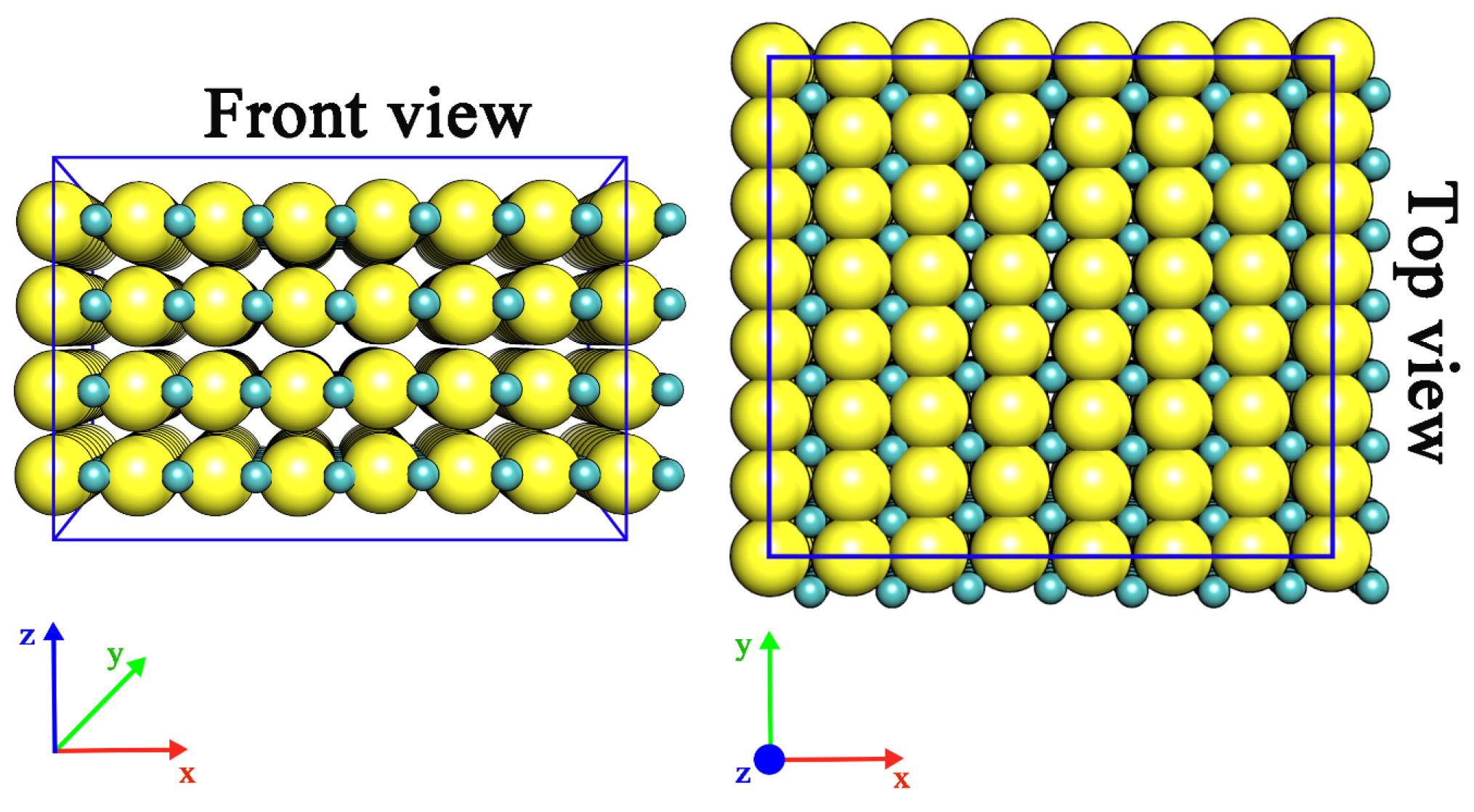
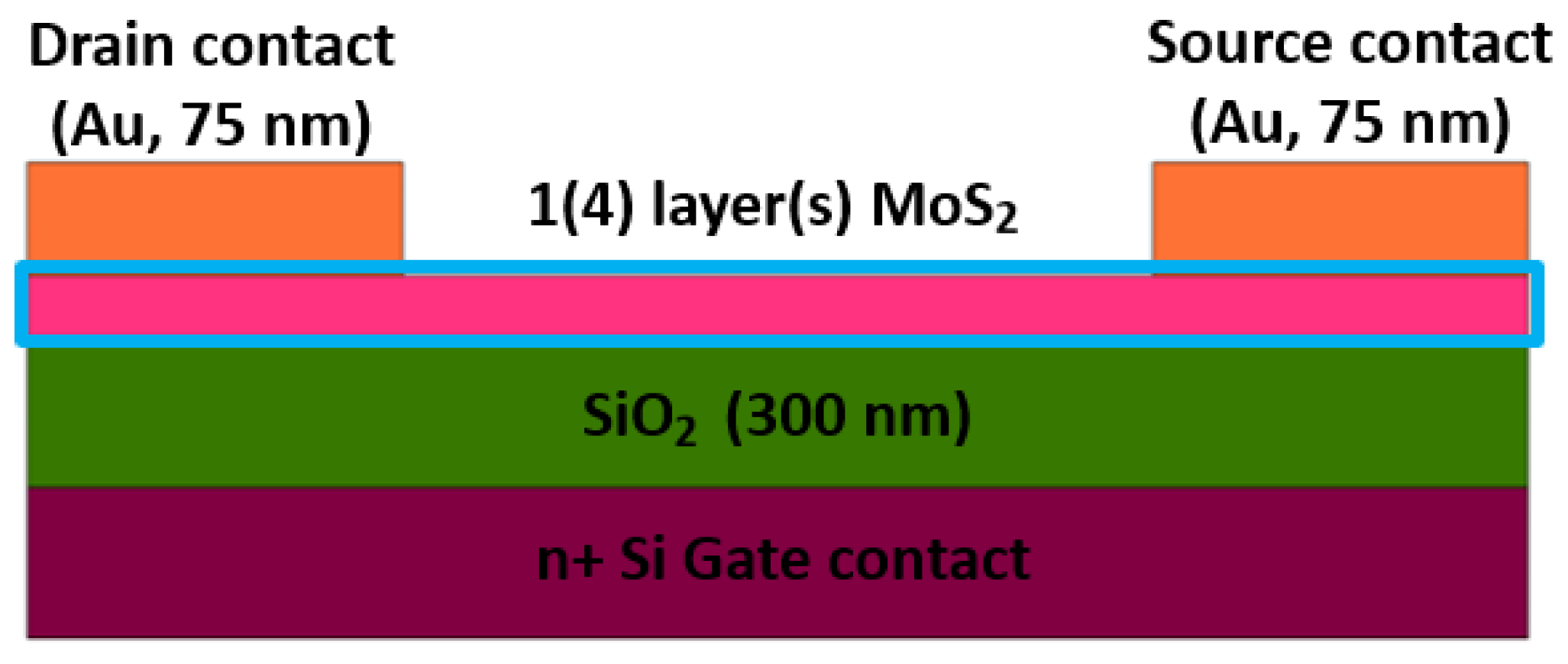
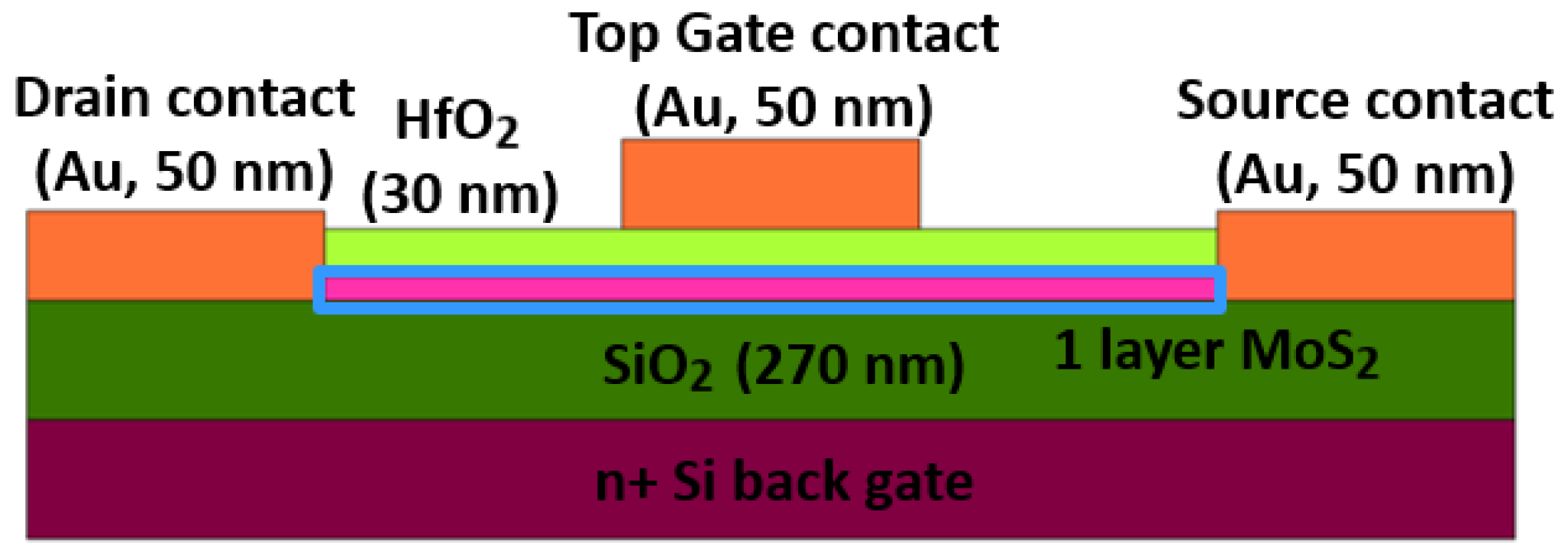

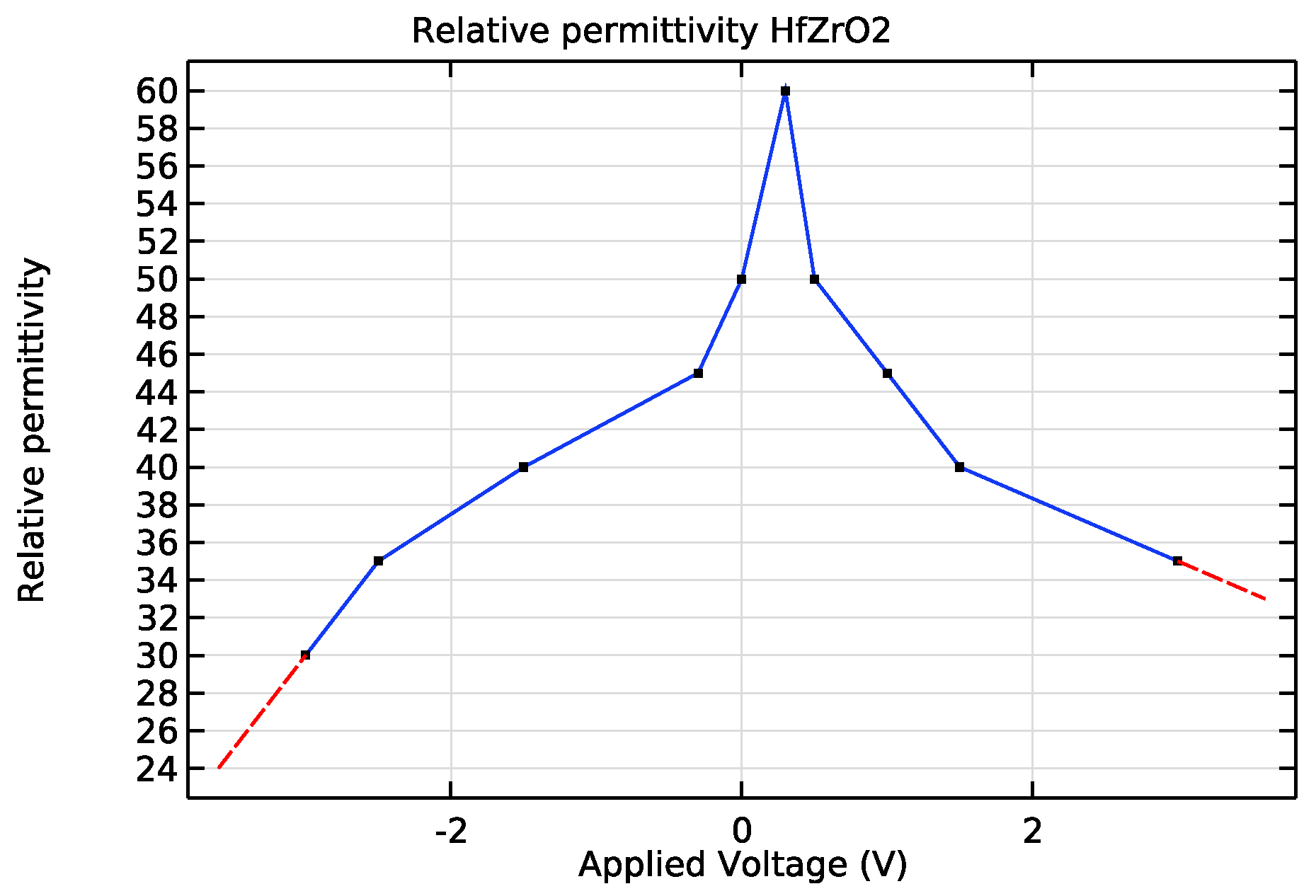
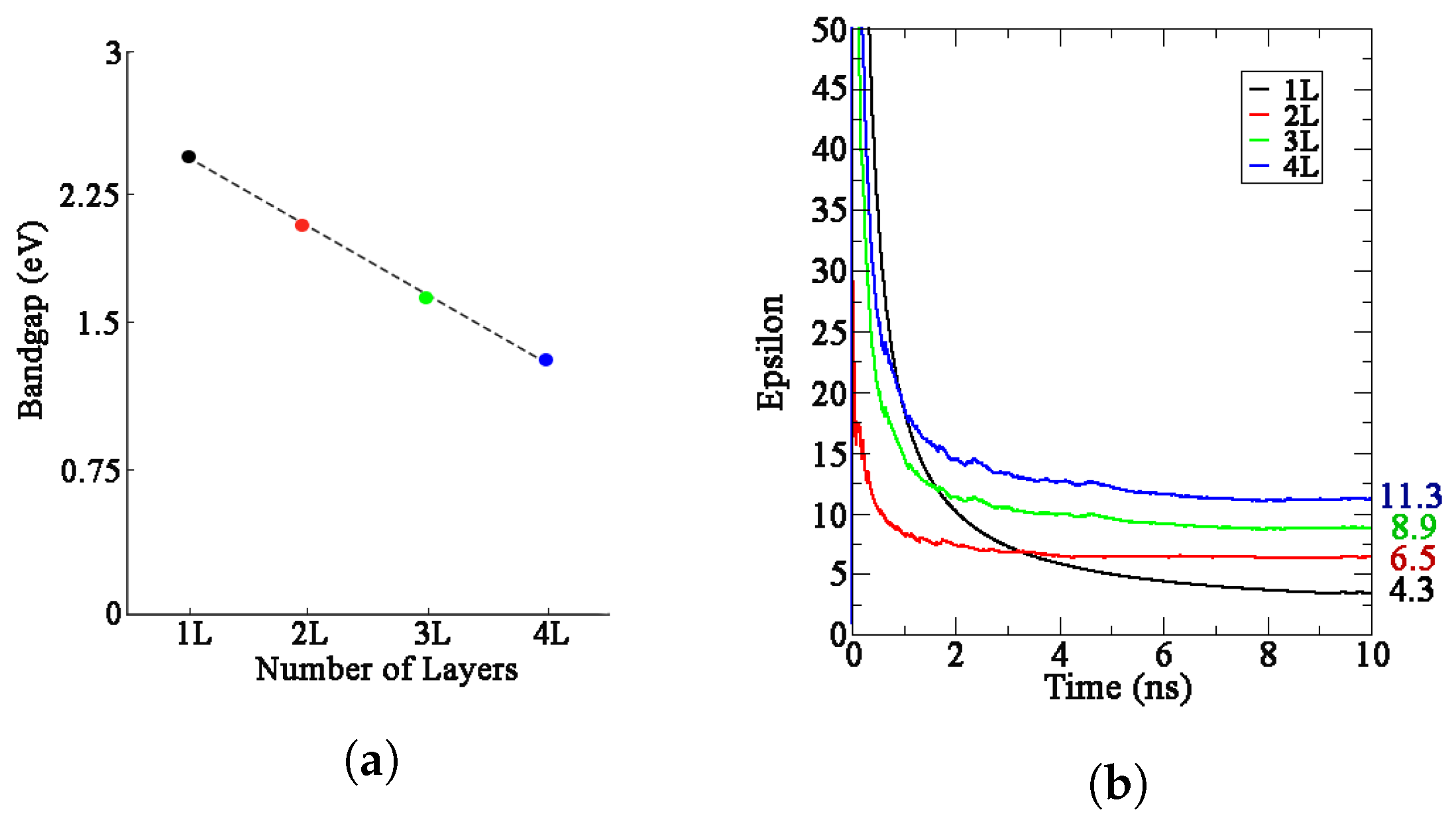


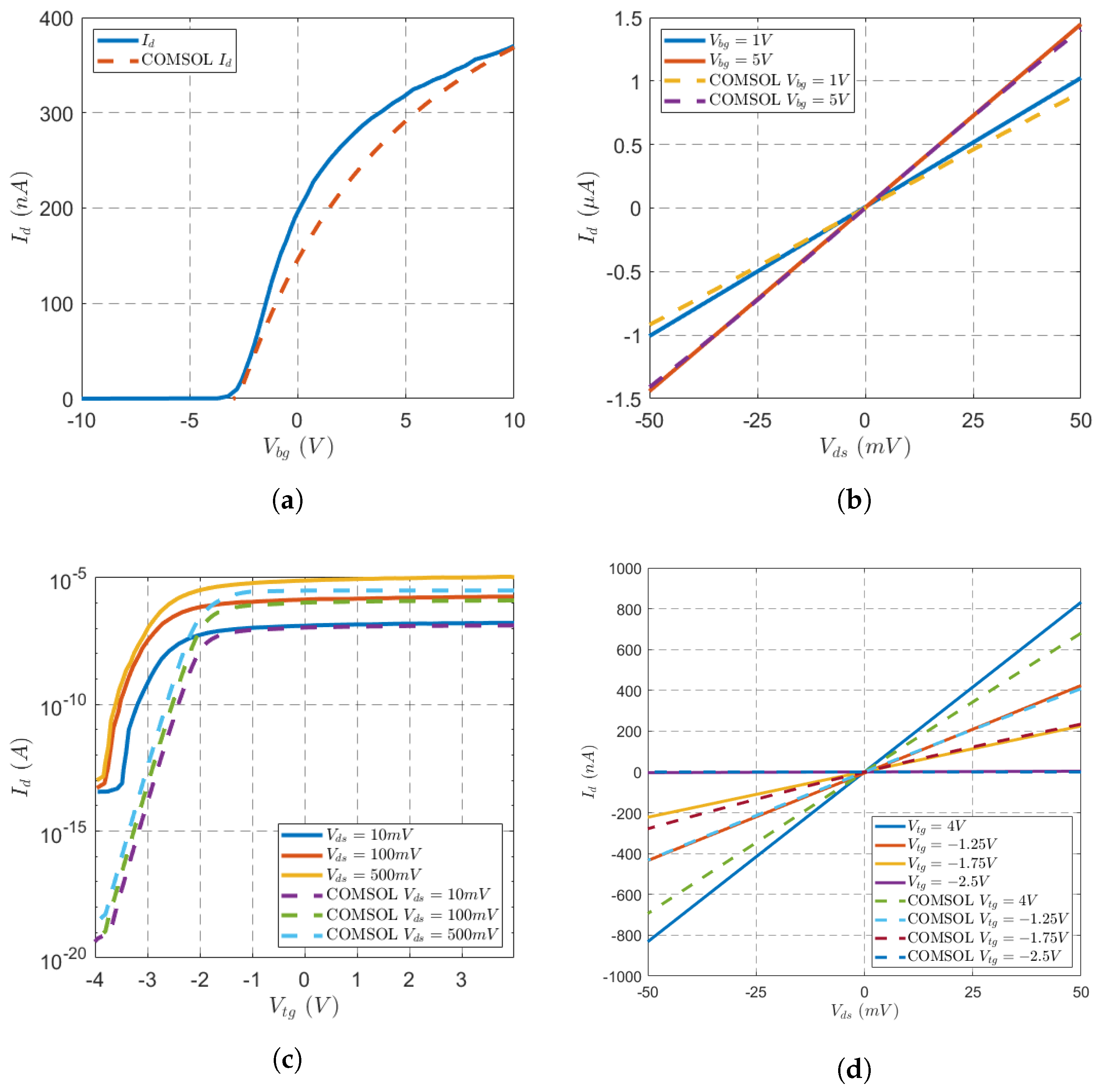
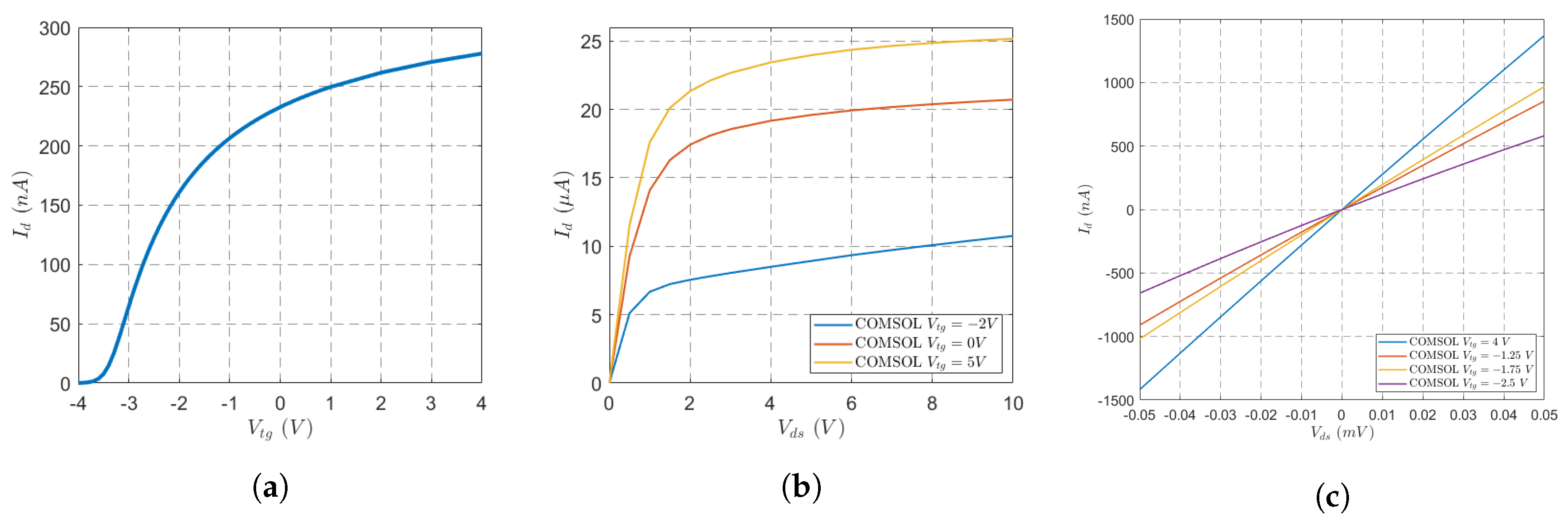

| Parameter | Value | Parameter | Value |
|---|---|---|---|
| Thickness of MoS | /layer | Electron effective mass | 0.5 m |
| Bandgap 1L MoS | Hole effective mass | 0.5 m | |
| Bandgap 4L MoS | Thickness gold contact | 75 | |
| Electron affinity 1L Mo | Length MoS | ||
| Electron affinity 4L MoS | 4 | Silicon thickness | 2 |
| Relative permittivity 1L | 4.2 | SiO thickness | 300 |
| Relative permittivity 4L | 11 | Width | |
| Mobility 1L | 6 cm2 V−1 s−1 | Work function of gate | |
| Mobility 4L | 25 cm2 V−1 s−1 | SiO Relative Permittivity | 3.9 |
| Drain and Source contact type | Ideal ohmic | Donor concentration (N_D) | cm |
| Parameter | Value | Parameter | Value |
|---|---|---|---|
| Thickness of MoS | SiO Relative Permittivity | 3.9 | |
| Bandgap MoS | Electron effective mass | 0.5 m | |
| Electron affinity MoS | 5 | Hole effective mass | 0.5 m |
| Relative permittivity MoS | Gold contact length | 500 | |
| Relative permittivity HfO | 25 | Source-gate spacing | 500 |
| Mobility | 217 cm2 V−1 s−1 | Gate-drain spacing | 500 |
| SRH lifetimes | Thickness gold contact | 50 | |
| Metal work function of top gate | SiO thickness | 270 | |
| Work function of bottom gate | HfO thickness | 30 | |
| Metal work function source | Width | 4 | |
| Metal work function drain | Donor concentration (N_d) | cm |
| Parameter | Value | Parameter | Value |
|---|---|---|---|
| Thickness of MoS | HfZrO thickness | 6 nm | |
| Bandgap MoS | Electron effective mass | 0.5 m | |
| Electron affinity MoS | 5 | Hole effective mass | 0.5 m |
| Relative permittivity MoS | Gold contact length | 500 | |
| Relative permittivity HfO | 20 | Source-gate spacing | 500 |
| Mobility | 217 cm2 V−1 s−1 | Gate-drain spacing | 500 |
| SRH lifetimes | Thickness gold contact | 50 | |
| Metal work function of top gate | SiO thickness | 270 | |
| Work function of bottom gate | HfO thickness | 30 | |
| Metal work function source | Width | 4 | |
| Metal work function drain | Donor concentration (N_d) | cm |
© 2020 by the authors. Licensee MDPI, Basel, Switzerland. This article is an open access article distributed under the terms and conditions of the Creative Commons Attribution (CC BY) license (http://creativecommons.org/licenses/by/4.0/).
Share and Cite
Pelagalli, N.; Laudadio, E.; Stipa, P.; Mencarelli, D.; Pierantoni, L. Efficient and Versatile Modeling of Mono- and Multi-Layer MoS2 Field Effect Transistor. Electronics 2020, 9, 1385. https://doi.org/10.3390/electronics9091385
Pelagalli N, Laudadio E, Stipa P, Mencarelli D, Pierantoni L. Efficient and Versatile Modeling of Mono- and Multi-Layer MoS2 Field Effect Transistor. Electronics. 2020; 9(9):1385. https://doi.org/10.3390/electronics9091385
Chicago/Turabian StylePelagalli, Nicola, Emiliano Laudadio, Pierluigi Stipa, Davide Mencarelli, and Luca Pierantoni. 2020. "Efficient and Versatile Modeling of Mono- and Multi-Layer MoS2 Field Effect Transistor" Electronics 9, no. 9: 1385. https://doi.org/10.3390/electronics9091385
APA StylePelagalli, N., Laudadio, E., Stipa, P., Mencarelli, D., & Pierantoni, L. (2020). Efficient and Versatile Modeling of Mono- and Multi-Layer MoS2 Field Effect Transistor. Electronics, 9(9), 1385. https://doi.org/10.3390/electronics9091385









